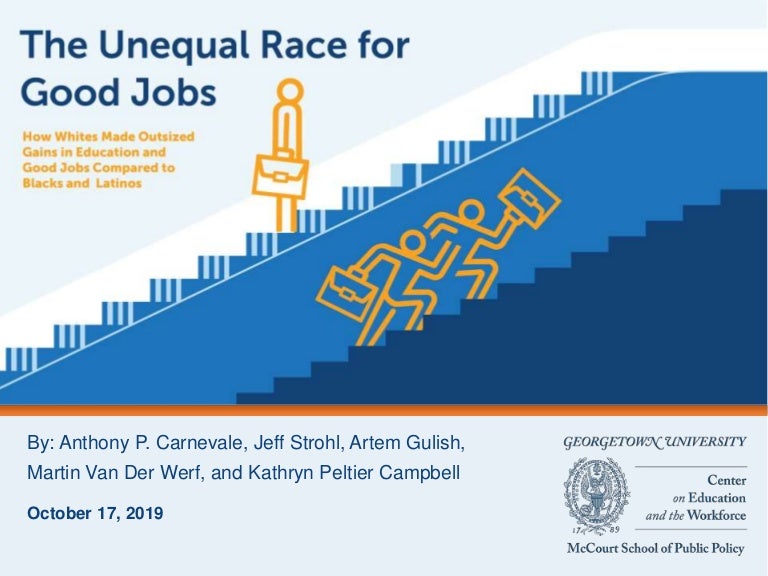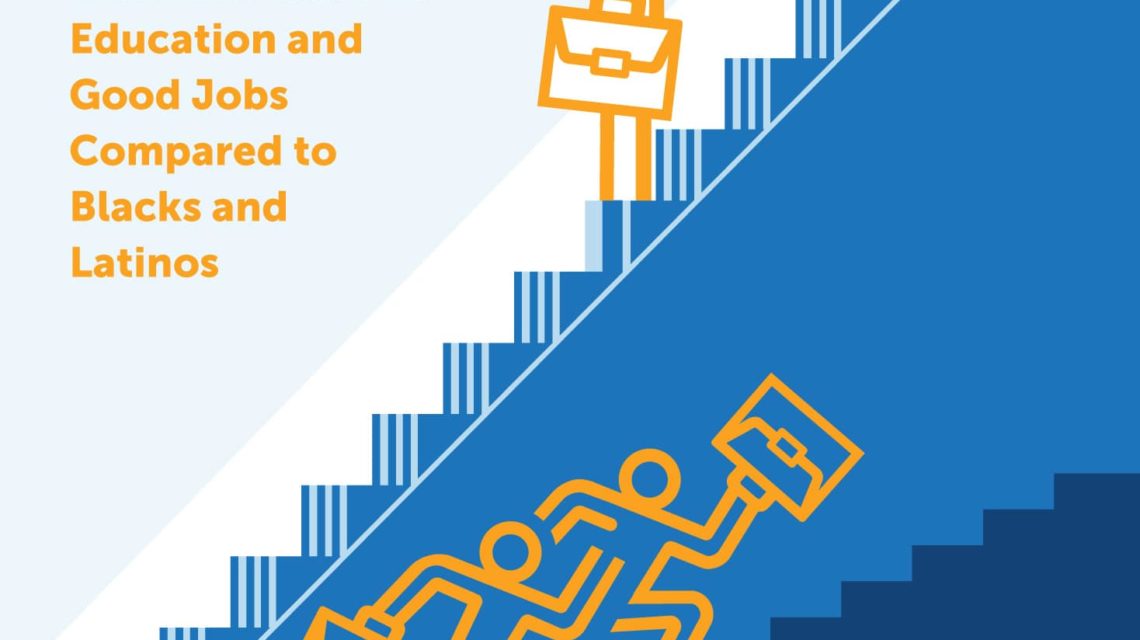Research by the Center on Education and the Workforce at Georgetown University
Among workers with good jobs, Whites have a total annual wage advantage of $554 billion
(Washington, DC) White workers have benefited from historical and systemic educational and economic advantages to build a disproportionate edge in the educational pipeline and the workforce that will continue to last for decades, according to new research from the Georgetown University Center on Education and the Workforce (CEW) as part of the Good Jobs Project, a research project by CEW and JPMorgan Chase & Co.
Black and Latino workers, on the other hand, face discrimination, racism, and other injustices that perpetuate inequities in education and the economy. The Unequal Race for Good Jobs: How Whites Made Outsized Gains in Education and Good Jobs Compared to Blacks and Latinos explores how the distribution of good jobs across educational attainment levels varies by race and ethnicity.

“This report is part of a broader project designed to surface new data on good jobs in the US economy that pay well for workers,” says Jennie Sparandara, head of workforce initiatives, JPMorgan Chase & Co. “Access to good jobs is one of our nation’s most urgent challenges, and this report defines the need to invest in workforce solutions for communities across the country to help those most at risk of falling behind.”
White, Black, and Latino workers all increased their likelihood of having a good job between 1991 and 2016, but equity gaps remain. White workers increased their share of good jobs from 50% to 58%. Over the same period, Black workers increased their share from 33% to 41% and Latino workers increased their share from 30% to 37%.
White workers are not only more likely to have a good job than their Black and Latino peers, but also hold a disproportionate share of good jobs relative to their share of overall employment, while Blacks and Latinos are underrepresented in good jobs. In 2016, White workers held 77% of good jobs in the United States even though they collectively held 69% of all jobs. Black workers held 10% of good jobs even as they held 13% of all jobs. Latino workers held 13% of good jobs, while they held 18% of all jobs.
“The White surge in college education sets up Whites for decades of continued economic dominance,” said Anthony P. Carnevale, lead author of the report and CEW director.
Black and Latino workers with good jobs are paid less than White workers with good jobs at every level of education. Among workers with good jobs, Whites are paid $554 billion more annually than they would be if good jobs and good jobs earnings were equitably distributed, whereas Blacks are paid $202 billion less and Latinos are paid $352 billion less.
In the past 25 years, there have been dramatic shifts in the distribution of workers along three educational pathways: high school, middle skills, and bachelor’s degree. White workers made a generational shift, from blue-collar jobs for workers with a high school education to skilled-services jobs for workers with bachelor’s degrees or higher. While White workers with a high school diploma or less have experienced major economic dislocation, White workers with college education have benefited the most from the rising demand for college-educated workers.
Black workers’ net gains in good jobs were on the bachelor’s degree and middle-skills pathways. The good news is that Black workers successfully moved out of the high school economy as opportunity on that pathway was shrinking. But on the whole, their gains only kept pace with the growth of good jobs in the overall economy.
Latino workers gained good jobs on all three educational pathways. They made significant gains on the bachelor’s degree pathway, and they were the only group to increase their number of good jobs on the high school pathway. But even though Latino workers have made significant advancement in educational attainment and access to good jobs, more Latino workers with a high school diploma or less are in low- wage jobs than in good jobs.
Other key findings:
● Even though Black and Latino unemployment rates have lowered considerably in the recovery, Black unemployment rates have remained approximately double those of Whites, and Latino unemployment rates have remained roughly 1.5 times those of Whites.
● Black workers have gained good jobs everywhere except in blue-collar industries on the high school pathway.
● In 2016, about 37% of all Latino good jobs were held by workers with no more than a high school diploma.
● In 2016, median earnings for good jobs on the bachelor’s degree pathway were $75,000 for White workers, compared to $65,000 for both Black and Latino workers.
“Without significant changes to the systems that perpetuate these inequities, they will continue for generations to come,” said Jeff Strohl, co-author of the report and CEW director of research.
Two major policy channels have the potential to close racial and ethnic equity gaps in good jobs: expanding educational opportunity and addressing discrimination.
Our recommendations include the following.
● Reward colleges that enroll and graduate students from underserved populations
● Increase funding for community colleges
● Ensure that counselors are trained to provide culturally competent counseling
● Invest in retraining of displaced workers
● Increase the funding and enforcement powers of the Equal Employment Opportunity Commission (EEOC)
● Promote industry and professional efforts to increase diversity
● Improve programs that incentivize economic development in underserved areas to ensure that these programs produce equitable outcomes
● Improve economic incentives for companies that make diversity, equity, and inclusion a key part of hiring
For the full report and a video highlighting key findings, visit cew.georgetown.edu/RaceandGoodJobs.
Note: We define a good job as one that pays family-sustaining earnings. Good jobs pay a minimum of $35,000 ($17 per hour for full-time jobs) for workers between the ages of 25 and 44 and at least $45,000 ($22 per hour) for workers between the ages of 45 and 64. In 2016, these good jobs paid median earnings of $56,000 for workers without a bachelor’s degree and $75,000 for workers with a bachelor’s degree or higher. Overall median earnings for all good jobs were $65,000.
###
The Georgetown University Center on Education and the Workforce is an independent, nonprofit research and policy institute that studies the link between individual goals, education and training curricula, and career pathways. CEW is affiliated with the Georgetown University McCourt School of Public Policy. For more information, visit cew.georgetown.edu.
JPMorgan Chase & Co. is a leading global financial services firm with assets of $2.6 trillion and operations worldwide.












